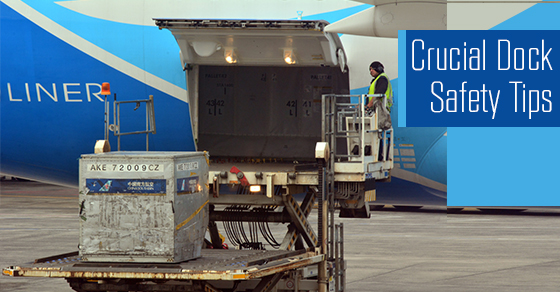Loading docks are very busy places, with people and heavy machinery with weighty loads coming and going, often 24/7. A bee hive place such as this is ripe for accidents. But it doesn’t have to be.
All it takes is for employees to start each working day with the thought, “Safety first.” It’s easy to lose sight of general safety practices when you’re trying to get through the work day, but the below tips are essential to workplace safety when dealing with loading docks.
-
- Remain vigilant at all times.
It’s crucial that you stay alert to all the sights and sounds on the loading dock. Watch out for materials that could fall. Listen for a forklift horn and clear out of the way. We don’t have eyes in the back of our heads, but we need to continuously work as though we do.
-
- Wear safety gear.
Protect yourself. Wear a hard hat, safety glasses and boots, ear protection if noise is a factor, and gloves that provide a good grip for lifting. Protective gear is not a sign of being a weakling – it’s a sign of professionalism.
- Observe a proper code of behavior.
- Don’t try to ride industrial vehicles you are not authorized for.
- Keep away from loading edges to prevent falls.
- Do not run – caution is diminished when you run. Don’t jump onto or off a loading dock — it can lead to serious ankle, knee and back injuries.
- Never come to work when under the influence of medications that will make you drowsy – being in that state not only places you in danger, but also creates hazards for your co-workers.
- Play your part in ensuring a safe working environment.
- To prevent slips and falls, make sure the floors of the loading dock are free of any spills and debris. Mop up any spills right away, and report any major spills (especially chemical spills) or cracks in the floor to your supervisor.
- Move all unnecessary materials out of walking paths.
- When driving a forklift on or off the loading dock, yield the right of way to people on foot crossing your path.
- When trucks arrive at the loading dock, have the drivers turn off their motors as soon as possible. Vehicle motors left running release carbon monoxide into the loading dock are. Carbon monoxide is odorless and invisible and can be fatal.
- Protect yourself when lifting or loading.
- Don’t try to be a hero—call for help or use forklifts or dollies for lifting heavy
loads. When you do lift, bend at your knees and keep your back straight, allowing your legs and not your back to do the lifting. This strategy will save you many hours at the physiotherapy clinic. - When loading a hand truck, secure the cargo carefully, and place the heaviest materials on the bottom, keeping the load’s height below your eye level, so you can see where you’re going.
- Don’t try to be a hero—call for help or use forklifts or dollies for lifting heavy
Ensure that all employees are aware of the safety rules and guidelines as they apply to stationary docks. Most manufacturing engineers will have experience on mobile docks, but there are different considerations needed when working with heavier, stationary platforms. Education is the key to safety, and every employee should be properly trained on acceptable behavior around the dock.


